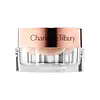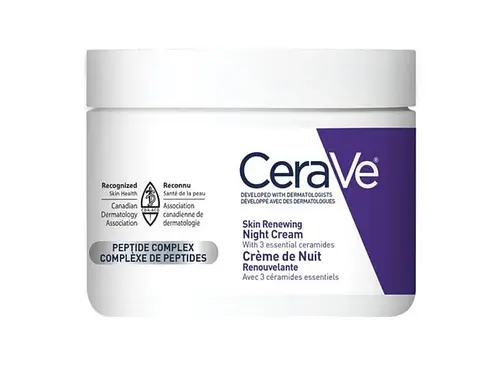What's inside
What's inside
 Key Ingredients
Key Ingredients

 Benefits
Benefits

 Concerns
Concerns

 Ingredients Side-by-side
Ingredients Side-by-side

Water
Skin ConditioningCaprylic/Capric Triglyceride
MaskingButylene Glycol
HumectantPolysorbate 60
EmulsifyingOlus Oil
EmollientPEG-7 Glyceryl Cocoate
EmulsifyingGlycerin
HumectantButyrospermum Parkii Butter
Skin ConditioningPEG-8
HumectantEthylhexyl Stearate
EmollientDicaprylyl Ether
EmollientSorbitan Stearate
EmulsifyingHydroxyethyl Acrylate/Sodium Acryloyldimethyl Taurate Copolymer
Emulsion StabilisingOlive Oil PEG-7 Esters
EmollientPhenoxyethanol
PreservativeSaccharide Isomerate
HumectantC12-16 Alcohols
EmollientCera Alba
EmollientGlyceryl Stearate
EmollientHydrogenated Castor Oil
EmollientSqualane
EmollientEthylhexylglycerin
Skin ConditioningChlorphenesin
AntimicrobialHydrogenated Lecithin
EmulsifyingHydrolyzed Rice Protein
Skin ConditioningPalmitic Acid
EmollientXanthan Gum
EmulsifyingChondrus Crispus Extract
Skin ConditioningDisodium EDTA
Helianthus Annuus Seed Oil
EmollientPolysorbate 20
EmulsifyingSorbitan Isostearate
EmulsifyingSodium Hydroxide
BufferingGlycine Soja Protein
EmulsifyingSuperoxide Dismutase
AntioxidantCitric Acid
BufferingHydroxypropyl Cyclodextrin
MaskingTocopherol
AntioxidantSodium Citrate
BufferingSodium Benzoate
MaskingSodium PCA
HumectantAscorbyl Palmitate
AntioxidantDaphne Odora Callus Extract
Skin ProtectingSodium Dextran Sulfate
Gel FormingNicotiana Sylvestris Leaf Cell Culture
Skin ConditioningAluminum Hydroxide
EmollientRetinol
Skin ConditioningPlumeria Rubra Flower Extract
Skin ConditioningBorago Officinalis Seed Oil
EmollientTocopheryl Acetate
AntioxidantAscorbic Acid
AntioxidantLecithin
EmollientPotassium Sorbate
PreservativeRetinyl Palmitate
Skin ConditioningAscorbyl Tetraisopalmitate
AntioxidantCI 77891
Cosmetic ColorantIron Oxides
Water, Caprylic/Capric Triglyceride, Butylene Glycol, Polysorbate 60, Olus Oil, PEG-7 Glyceryl Cocoate, Glycerin, Butyrospermum Parkii Butter, PEG-8, Ethylhexyl Stearate, Dicaprylyl Ether, Sorbitan Stearate, Hydroxyethyl Acrylate/Sodium Acryloyldimethyl Taurate Copolymer, Olive Oil PEG-7 Esters, Phenoxyethanol, Saccharide Isomerate, C12-16 Alcohols, Cera Alba, Glyceryl Stearate, Hydrogenated Castor Oil, Squalane, Ethylhexylglycerin, Chlorphenesin, Hydrogenated Lecithin, Hydrolyzed Rice Protein, Palmitic Acid, Xanthan Gum, Chondrus Crispus Extract, Disodium EDTA, Helianthus Annuus Seed Oil, Polysorbate 20, Sorbitan Isostearate, Sodium Hydroxide, Glycine Soja Protein, Superoxide Dismutase, Citric Acid, Hydroxypropyl Cyclodextrin, Tocopherol, Sodium Citrate, Sodium Benzoate, Sodium PCA, Ascorbyl Palmitate, Daphne Odora Callus Extract, Sodium Dextran Sulfate, Nicotiana Sylvestris Leaf Cell Culture, Aluminum Hydroxide, Retinol, Plumeria Rubra Flower Extract, Borago Officinalis Seed Oil, Tocopheryl Acetate, Ascorbic Acid, Lecithin, Potassium Sorbate, Retinyl Palmitate, Ascorbyl Tetraisopalmitate, CI 77891, Iron Oxides
Water
Skin ConditioningGlycerin
HumectantCaprylic/Capric Triglyceride
MaskingButyrospermum Parkii Butter
Skin ConditioningDimethicone/Vinyl Dimethicone Crosspolymer
Skin ConditioningCyclopentasiloxane
EmollientGlyceryl Stearate Se
EmulsifyingCetyl Alcohol
EmollientDimethicone
EmollientSaccharide Isomerate
HumectantStearic Acid
CleansingPalmitic Acid
EmollientGlycine Soja Sterols
EmollientAllantoin
Skin ConditioningCeramide NP
Skin ConditioningCeramide AP
Skin ConditioningCeramide EOP
Skin ConditioningCarbomer
Emulsion StabilisingNiacinamide
SmoothingCetearyl Alcohol
EmollientBehentrimonium Methosulfate
Sodium Hydroxide
BufferingMyristic Acid
CleansingSodium Lauroyl Lactylate
EmulsifyingSodium Benzoate
MaskingSodium Citrate
BufferingSodium Hyaluronate
HumectantCholesterol
EmollientPhenoxyethanol
PreservativeTocopherol
AntioxidantTripeptide-1
Skin ConditioningLaureth-9
EmulsifyingCitric Acid
BufferingCaprooyl Tetrapeptide-3
Skin ProtectingBiosaccharide Gum-1
HumectantPhytosphingosine
Skin ConditioningXanthan Gum
EmulsifyingDextran
Ethylhexylglycerin
Skin ConditioningButylene Glycol
HumectantWater, Glycerin, Caprylic/Capric Triglyceride, Butyrospermum Parkii Butter, Dimethicone/Vinyl Dimethicone Crosspolymer, Cyclopentasiloxane, Glyceryl Stearate Se, Cetyl Alcohol, Dimethicone, Saccharide Isomerate, Stearic Acid, Palmitic Acid, Glycine Soja Sterols, Allantoin, Ceramide NP, Ceramide AP, Ceramide EOP, Carbomer, Niacinamide, Cetearyl Alcohol, Behentrimonium Methosulfate, Sodium Hydroxide, Myristic Acid, Sodium Lauroyl Lactylate, Sodium Benzoate, Sodium Citrate, Sodium Hyaluronate, Cholesterol, Phenoxyethanol, Tocopherol, Tripeptide-1, Laureth-9, Citric Acid, Caprooyl Tetrapeptide-3, Biosaccharide Gum-1, Phytosphingosine, Xanthan Gum, Dextran, Ethylhexylglycerin, Butylene Glycol
 Reviews
Reviews

Ingredients Explained
These ingredients are found in both products.
Ingredients higher up in an ingredient list are typically present in a larger amount.
Butylene Glycol (or BG) is used within cosmetic products for a few different reasons:
Overall, Butylene Glycol is a safe and well-rounded ingredient that works well with other ingredients.
Though this ingredient works well with most skin types, some people with sensitive skin may experience a reaction such as allergic rashes, closed comedones, or itchiness.
Learn more about Butylene GlycolThis ingredient is also known as shea butter. It is an effective skin hydrator and emollient.
Emollients help soothe and soften your skin. It does this by creating a protective film on your skin. This barrier helps trap moisture and keeps your skin hydrated. Emollients may be effective at treating dry or itchy skin.
Shea butter is rich in antioxidants. Antioxidants help fight free-radicals, or molecules that may harm the body. It is also full of fatty acids including stearic acid and linoleic acid. These acids help replenish the skin and keep skin moisturized.
While Shea Butter has an SPF rating of about 3-4, it is not a sunscreen replacement.
Shea butter may not be fungal acne safe. We recommend speaking with a professional if you have any concerns.
Learn more about Butyrospermum Parkii ButterThis ingredient is an emollient, solvent, and texture enhancer. It is considered a skin-softener by helping the skin prevent moisture loss.
It helps thicken a product's formula and makes it easier to spread by dissolving clumping compounds.
Caprylic Triglyceride is made by combining glycerin with coconut oil, forming a clear liquid.
While there is an assumption Caprylic Triglyceride can clog pores due to it being derived from coconut oil, there is no research supporting this.
Learn more about Caprylic/Capric TriglycerideCitric Acid is an alpha hydroxy acid (AHA) naturally found in citrus fruits like oranges, lemons, and limes.
Like other AHAs, citric acid can exfoliate skin by breaking down the bonds that hold dead skin cells together. This helps reveal smoother and brighter skin underneath.
However, this exfoliating effect only happens at high concentrations (20%) which can be hard to find in cosmetic products.
Due to this, citric acid is usually included in small amounts as a pH adjuster. This helps keep products slightly more acidic and compatible with skin's natural pH.
In skincare formulas, citric acid can:
While it can provide some skin benefits, research shows lactic acid and glycolic acid are generally more effective and less irritating exfoliants.
Most citric acid used in skincare today is made by fermenting sugars (usually from molasses). This synthetic version is identical to the natural citrus form but easier to stabilize and use in formulations.
Read more about some other popular AHA's here:
Learn more about Citric AcidEthylhexylglycerin (we can't pronounce this either) is commonly used as a preservative and skin softener. It is derived from glyceryl.
You might see Ethylhexylglycerin often paired with other preservatives such as phenoxyethanol. Ethylhexylglycerin has been found to increase the effectiveness of these other preservatives.
Glycerin is already naturally found in your skin. It helps moisturize and protect your skin.
A study from 2016 found glycerin to be more effective as a humectant than AHAs and hyaluronic acid.
As a humectant, it helps the skin stay hydrated by pulling moisture to your skin. The low molecular weight of glycerin allows it to pull moisture into the deeper layers of your skin.
Hydrated skin improves your skin barrier; Your skin barrier helps protect against irritants and bacteria.
Glycerin has also been found to have antimicrobial and antiviral properties. Due to these properties, glycerin is often used in wound and burn treatments.
In cosmetics, glycerin is usually derived from plants such as soybean or palm. However, it can also be sourced from animals, such as tallow or animal fat.
This ingredient is organic, colorless, odorless, and non-toxic.
Glycerin is the name for this ingredient in American English. British English uses Glycerol/Glycerine.
Learn more about GlycerinPalmitic Acid is a fatty acid naturally found in our skin and in many plant and animal sources. In cosmetics, it is usually derived from palm oil. It serves many purposes in skincare, acting as a cleanser, emollient, and emulsifier.
As an emollient, palmitic acid helps soften and smooth the skin by preventing water loss. In cleansers, it helps remove oil and dirt while creating foam.
Its emulsifying properties help stabilize products by keeping water and oil-based ingredients from separating.
This may not be suitable for fungal acne-prone skin, as fatty acids like this can sometimes trigger breakouts in sensitive individuals.
Learn more about Palmitic AcidPhenoxyethanol is a preservative that has germicide, antimicrobial, and aromatic properties. Studies show that phenoxyethanol can prevent microbial growth. By itself, it has a scent that is similar to that of a rose.
It's often used in formulations along with Caprylyl Glycol to preserve the shelf life of products.
Saccharide Isomerate comes from sugars found in corn. It is a skin hydrator.
The structure of this ingredient can be altered to be more similar to the carbohydrates found in our skin. This ability to mimic our skin gives it hydrating properties.
Specifically, saccharide Isomerate is a humectant. Humectants draw moisture from the air to our skin.
Research shows Saccharide Isomerate to be an effective moisturizer.
Learn more about Saccharide IsomerateSodium Benzoate is a preservative. It's used in both cosmetic and food products to inhibit the growth of mold and bacteria. It is typically produced synthetically.
Both the US FDA and EU Health Committee have approved the use of sodium benzoate. In the US, levels of 0.1% (of the total product) are allowed.
Sodium benzoate works as a preservative by inhibiting the growth of bacteria inside of cells. It prevents the cell from fermenting a type of sugar using an enzyme called phosphofructokinase.
It is the salt of benzoic acid. Foods containing sodium benzoate include soda, salad dressings, condiments, fruit juices, wines, and snack foods.
Studies for using ascorbic acid and sodium benzoate in cosmetics are lacking, especially in skincare routines with multiple steps.
We always recommend speaking with a professional, such as a dermatologist, if you have any concerns.
Learn more about Sodium BenzoateSodium Citrate is the sodium salts of citric acid. In skincare, it is used to alter pH levels and acts as a preservative.
Its main functions are to maintain the pH of a product and neutralize metal ions.
The acidity of our skin is maintained by our glands and skin biome; normal pH level of skin is slightly acidic (~4.75-5.5).
Being slightly acidic allows our skin to create an "acid mantle". This acid mantle is a thin barrier that protects our skin from bacteria and contaminants.
Learn more about Sodium CitrateSodium Hydroxide is also known as lye or caustic soda. It is used to adjust the pH of products; many ingredients require a specific pH to be effective.
In small amounts, sodium hydroxide is considered safe to use. However, large amounts may cause chemical burns due to its high alkaline.
Your skin has a natural pH and acid mantle. This acid mantle helps prevent harmful bacteria from breaking through. The acid mantle also helps keep your skin hydrated.
"Alkaline" refers to a high pH level. A low pH level would be considered acidic.
Learn more about Sodium HydroxideTocopherol (also known as Vitamin E) is a common antioxidant used to help protect the skin from free-radicals and strengthen the skin barrier. It's also fat soluble - this means our skin is great at absorbing it.
Vitamin E also helps keep your natural skin lipids healthy. Your lipid skin barrier naturally consists of lipids, ceramides, and fatty acids. Vitamin E offers extra protection for your skin’s lipid barrier, keeping your skin healthy and nourished.
Another benefit is a bit of UV protection. Vitamin E helps reduce the damage caused by UVB rays. (It should not replace your sunscreen). Combining it with Vitamin C can decrease sunburned cells and hyperpigmentation after UV exposure.
You might have noticed Vitamin E + C often paired together. This is because it is great at stabilizing Vitamin C. Using the two together helps increase the effectiveness of both ingredients.
There are often claims that Vitamin E can reduce/prevent scarring, but these claims haven't been confirmed by scientific research.
Learn more about TocopherolWater. It's the most common cosmetic ingredient of all. You'll usually see it at the top of ingredient lists, meaning that it makes up the largest part of the product.
So why is it so popular? Water most often acts as a solvent - this means that it helps dissolve other ingredients into the formulation.
You'll also recognize water as that liquid we all need to stay alive. If you see this, drink a glass of water. Stay hydrated!
Learn more about WaterXanthan gum is used as a stabilizer and thickener within cosmetic products. It helps give products a sticky, thick feeling - preventing them from being too runny.
On the technical side of things, xanthan gum is a polysaccharide - a combination consisting of multiple sugar molecules bonded together.
Xanthan gum is a pretty common and great ingredient. It is a natural, non-toxic, non-irritating ingredient that is also commonly used in food products.
Learn more about Xanthan Gum